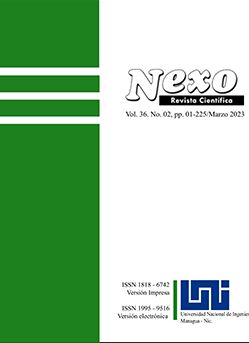Modelado Numérico de Pilotes de Retención y Comparación de Resultados con Relaciones Teóricas
DOI:
https://doi.org/10.5377/nexo.v36i02.16061Palabras clave:
Pilote, Suelo, Análisis Numérico, Estructura de ContenciónResumen
En esta investigación se investigó la estructura de contención del proyecto, que se implementó como un pilote. Para investigar esta investigación, los modelos fueron modelados en el software ABAQUS y cargados estáticamente. Después de analizar la estructura de contención mencionada anteriormente con el suelo de modelado, se muestra que, al aumentar la distancia entre los pilotes, se incrementan las tensiones y deformaciones en el suelo entre ellos y se obtiene un suelo más crítico. También se observa que la cantidad de tensión y su distribución en los pilotes en el momento en que sus distancias son menores es mayor que la de su distancia entre ellos se incrementó. Asimismo, la comparación de los resultados numéricos con los resultados de las relaciones teóricas indica que los valores numéricos son mayores que los valores obtenidos a partir de las relaciones teóricas.
Descargas
Descargas
Publicado
Cómo citar
Número
Sección
Licencia
Derechos de autor 2023 Universidad Nacional de Ingeniería

Esta obra está bajo una licencia internacional Creative Commons Atribución 4.0.
Los autores que publican en Nexo Revista Científica están de acuerdo con los siguientes términos:
- Los autores conservan los derechos de autor y conceden a la revista el derecho de la primera publicación bajo la licencia Creative Commons Attribution License https://creativecommons.org/licenses/by/3.0/, que permite a otros compartir el trabajo con un reconocimiento a la autoría de la obra y a la publicación inicial en Nexo Revista Científica.
- Los autores pueden establecer por separado acuerdos adicionales para la distribución no exclusiva de la versión de la obra publicada en la revista (por ejemplo, en un repositorio institucional o en un libro) con el reconocimiento de su publicación inicial en Nexo Revista Científica.
- Se permite y se anima a los autores a difundir sus trabajos electrónicamente (por ejemplo, en repositorios institucionales o en su propio sitio web) antes y durante el proceso de envío, ya que puede dar lugar a intercambios productivos, así como a una citación más temprana y mayor de los trabajos publicados.











